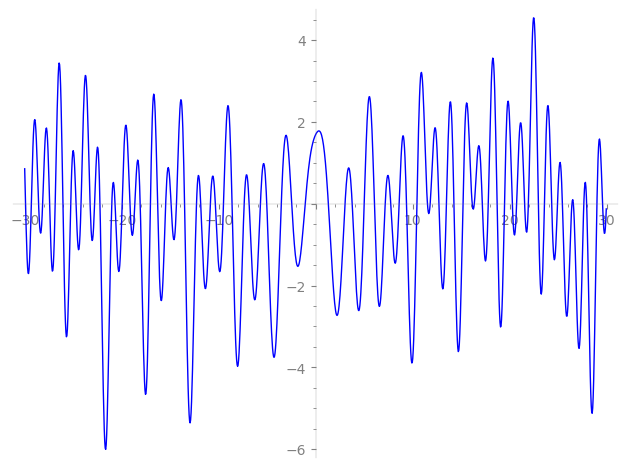| L(s) = 1 | + (−0.100 − 0.173i)2-s + (0.979 − 1.69i)4-s + (−0.556 + 0.964i)5-s + (0.359 + 0.622i)7-s − 0.793·8-s + 0.223·10-s + (0.874 + 1.51i)11-s + (0.587 − 1.01i)13-s + (0.0719 − 0.124i)14-s + (−1.88 − 3.25i)16-s + 4.38·17-s + 4.97·19-s + (1.09 + 1.88i)20-s + (0.175 − 0.303i)22-s + (3.61 − 6.26i)23-s + ⋯ |
| L(s) = 1 | + (−0.0708 − 0.122i)2-s + (0.489 − 0.848i)4-s + (−0.248 + 0.431i)5-s + (0.135 + 0.235i)7-s − 0.280·8-s + 0.0705·10-s + (0.263 + 0.456i)11-s + (0.163 − 0.282i)13-s + (0.0192 − 0.0333i)14-s + (−0.470 − 0.814i)16-s + 1.06·17-s + 1.14·19-s + (0.243 + 0.422i)20-s + (0.0373 − 0.0647i)22-s + (0.754 − 1.30i)23-s + ⋯ |
\[\begin{aligned}\Lambda(s)=\mathstrut & 783 ^{s/2} \, \Gamma_{\C}(s) \, L(s)\cr =\mathstrut & (0.806 + 0.591i)\, \overline{\Lambda}(2-s) \end{aligned}\]
\[\begin{aligned}\Lambda(s)=\mathstrut & 783 ^{s/2} \, \Gamma_{\C}(s+1/2) \, L(s)\cr =\mathstrut & (0.806 + 0.591i)\, \overline{\Lambda}(1-s) \end{aligned}\]
Particular Values
| \(L(1)\) |
\(\approx\) |
\(1.61145 - 0.527401i\) |
| \(L(\frac12)\) |
\(\approx\) |
\(1.61145 - 0.527401i\) |
| \(L(\frac{3}{2})\) |
|
not available |
| \(L(1)\) |
|
not available |
\(L(s) = \displaystyle \prod_{p} F_p(p^{-s})^{-1} \)
| $p$ | $F_p(T)$ |
|---|
| bad | 3 | \( 1 \) |
| 29 | \( 1 + (0.5 + 0.866i)T \) |
| good | 2 | \( 1 + (0.100 + 0.173i)T + (-1 + 1.73i)T^{2} \) |
| 5 | \( 1 + (0.556 - 0.964i)T + (-2.5 - 4.33i)T^{2} \) |
| 7 | \( 1 + (-0.359 - 0.622i)T + (-3.5 + 6.06i)T^{2} \) |
| 11 | \( 1 + (-0.874 - 1.51i)T + (-5.5 + 9.52i)T^{2} \) |
| 13 | \( 1 + (-0.587 + 1.01i)T + (-6.5 - 11.2i)T^{2} \) |
| 17 | \( 1 - 4.38T + 17T^{2} \) |
| 19 | \( 1 - 4.97T + 19T^{2} \) |
| 23 | \( 1 + (-3.61 + 6.26i)T + (-11.5 - 19.9i)T^{2} \) |
| 31 | \( 1 + (0.127 - 0.220i)T + (-15.5 - 26.8i)T^{2} \) |
| 37 | \( 1 + 6.12T + 37T^{2} \) |
| 41 | \( 1 + (-2.52 + 4.36i)T + (-20.5 - 35.5i)T^{2} \) |
| 43 | \( 1 + (3.94 + 6.82i)T + (-21.5 + 37.2i)T^{2} \) |
| 47 | \( 1 + (-2.05 - 3.55i)T + (-23.5 + 40.7i)T^{2} \) |
| 53 | \( 1 - 7.37T + 53T^{2} \) |
| 59 | \( 1 + (1.94 - 3.36i)T + (-29.5 - 51.0i)T^{2} \) |
| 61 | \( 1 + (-2.59 - 4.48i)T + (-30.5 + 52.8i)T^{2} \) |
| 67 | \( 1 + (-3.74 + 6.48i)T + (-33.5 - 58.0i)T^{2} \) |
| 71 | \( 1 + 5.68T + 71T^{2} \) |
| 73 | \( 1 + 10.1T + 73T^{2} \) |
| 79 | \( 1 + (-6.19 - 10.7i)T + (-39.5 + 68.4i)T^{2} \) |
| 83 | \( 1 + (-5.47 - 9.47i)T + (-41.5 + 71.8i)T^{2} \) |
| 89 | \( 1 - 0.231T + 89T^{2} \) |
| 97 | \( 1 + (-5.16 - 8.94i)T + (-48.5 + 84.0i)T^{2} \) |
| show more | |
| show less | |
\(L(s) = \displaystyle\prod_p \ \prod_{j=1}^{2} (1 - \alpha_{j,p}\, p^{-s})^{-1}\)
Imaginary part of the first few zeros on the critical line
−10.34919322558312371652054855910, −9.506070297028001909322267329278, −8.625261487426598115977263467933, −7.37515453670735220183598908516, −6.86522712909953740828674386386, −5.70239856477645631549188708032, −5.04721893846865060829551843462, −3.55017496591453477287074930882, −2.47359665137835809859434733088, −1.08494816576396977923327358120,
1.30304353423381473875338654881, 3.02116468375862329766293713904, 3.75883505575968947504122775195, 4.99602267381496048722148033630, 6.05023366969664551188774164353, 7.16291339630465789296139291282, 7.73079874607738205471591390122, 8.596378465669394032727617838831, 9.357620769967471496769132276054, 10.42878087336872256713471205929

